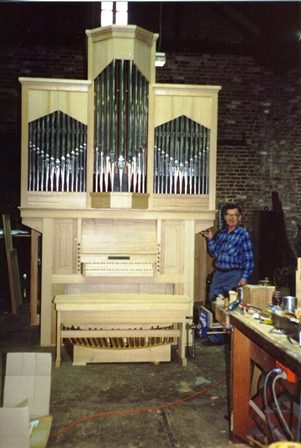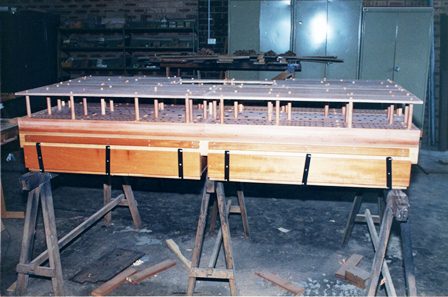CHAPEL ORGAN See Also the
Wurlitzer Organ in the George Logie Smith Auditorium at the Keith Humble Centre for Music and the Performing Arts.
The Geelong College Chapel Organ was installed in the renovated and extended
Geelong College Chapel at Senior School in 1993. This fine two-manual mechanical organ of 11 speaking stops was built by Roger H Pogson (1932-) of Orange, NSW. Like the other organs in Victoria built by him, at Melba Hall, University of Melbourne and Christ Church, Brunswick, its tonal design, appearance, action and location follow that of the classic organs of eighteenth century Europe and it is particularly suited to the playing of 17th, 18th and 20th century pieces. One of the design criteria for this organ was that it should be able to produce an
‘excellent account of Mendelssohn’s Wedding March’ The organ is as large as the space, particularly the height, of the Chapel gallery will allow. Nevertheless it has all the features of an organ required to lead congregational singing, to play a significant portion of the repertoire of organ music, and for teaching and practice. The organ is placed on a rear gallery accessed by a spiral stair.
The construction of the organ was commissioned in 1989, the year the former House of Music was adapted and enlarged for use as the Geelong College Chapel. Mr D William Martin, a member of the Uniting Church Committee on Church Music, acted as consultant for the project. Its final contract cost was $104,000 most of which was supported by a donation of $75,000.
The specification includes the following description:
‘It has a complementary yet contrasted chorus on each of the two manuals, made up of individual ranks (stops) which provide significant variety of tone colour. In all, the organ has 690 pipes made of tin, spotten metal, plain metal and wood, of which 368 belong to the lower keyboard (Great Organ), 280 belong to the upper keyboard (Positive Organ) and the remaining 42 pipes belong to the Paddle Organ while a hitchdown pedal activates the Trimulant. There are seven stop knobs on either side of the keyboard with the builder’s name, Roger Podson, prominent between them.
All of the manual pipes stand on a common slider windchest supplied from a double-rise reservoir. For economy of space within the organ, the encased electric blower is located beside it. The case of polished Tasmanian oak not only contains the organ and enhances its appearance, but also helps to project its sound in the Chapel. The 36 pure tin display pipes are drawn from the Principal and Sifflute ranks. Mechanical (tracker) action is used for the manuals and the pedals. In addition to having proved to be the most durable, this type of action enables a player, by careful control of touch, to vary the speech of the pipes for artistic effect. The stop action is also mechanical; the tremulant is activated by a hitch-down pedal and the height of the bench may be adjusted as required.’ 
Roger Pogson with the College Organ
during construction.

Organ Windchest during construction.
Principal 8 to BB, grooved bass below
Spill Flute 8 stopped bass, open metal treble
Octave 4
Sifflute 2
Mixture 19.22.26 III
POSITIVEGedackt 8 stopped metal treble
Gemshorn 4
Principal 2
Sesquialtera 19.24/12.17 II
PEDALSubbass 16 A
Flute 8 A
Sources: Organ Historical Trust of Australia News Vol 17 No 2 April, 1993; Ad Astra April 1993 p3. Organ Historical Trust of Australia (www.ohta.org.au/organs/GeelongCollege.html)''